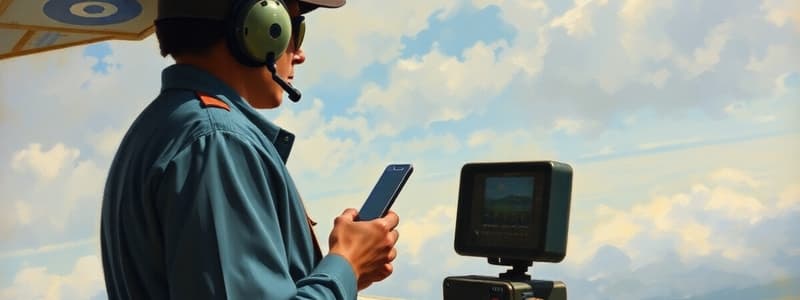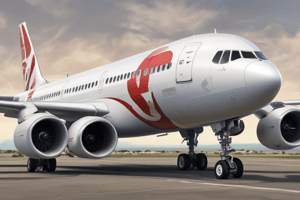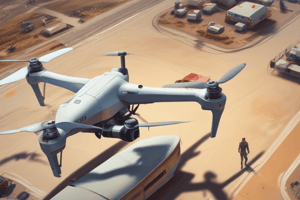Podcast
Questions and Answers
What is the responsibility of the PIC regarding gear pins?
What is the responsibility of the PIC regarding gear pins?
- To ensure they are painted
- To ensure the correct number are stowed onboard (correct)
- To ensure they are tested
- To ensure they are properly installed
The engagement of the battery should be checked only if the aircraft has not been electrically supplied for less than 6 hours.
The engagement of the battery should be checked only if the aircraft has not been electrically supplied for less than 6 hours.
False (B)
What should the battery voltage be above to ensure a charge above 50%?
What should the battery voltage be above to ensure a charge above 50%?
25.5 V
Ensure that the __________ selector remains on the APU position to avoid discharge of BAT 1 or 2.
Ensure that the __________ selector remains on the APU position to avoid discharge of BAT 1 or 2.
Match the following cockpit elements with their functions:
Match the following cockpit elements with their functions:
Why should ground personnel connect EXT PWR A when only one electrical power source is available?
Why should ground personnel connect EXT PWR A when only one electrical power source is available?
What happens if AVAIL does not illuminate when EXT PWR is connected?
What happens if AVAIL does not illuminate when EXT PWR is connected?
What is not allowed when using EXT PWR B?
What is not allowed when using EXT PWR B?
What should be done to reset the GPCU protection after a trip?
What should be done to reset the GPCU protection after a trip?
Which of the following statements is true regarding the connection of EXT PWR A?
Which of the following statements is true regarding the connection of EXT PWR A?
Flashcards
Landing Gear Pins and Covers
Landing Gear Pins and Covers
PIC is responsible for verifying the correct number of gear pins are on board.
ENG 1, 2 Masters Levers
ENG 1, 2 Masters Levers
Aircraft engine levers to control engine startup and operation.
ENG Start Selector
ENG Start Selector
Selector to initiate engine starting procedures.
Weather Radar Setup
Weather Radar Setup
Signup and view all the flashcards
Windshear/PWS Switch
Windshear/PWS Switch
Signup and view all the flashcards
Radar Gain Knob
Radar Gain Knob
Signup and view all the flashcards
Radar Mode Selector
Radar Mode Selector
Signup and view all the flashcards
L/G Lever
L/G Lever
Signup and view all the flashcards
WIPER Selectors
WIPER Selectors
Signup and view all the flashcards
Battery Check/External Power
Battery Check/External Power
Signup and view all the flashcards
Battery Voltage Check
Battery Voltage Check
Signup and view all the flashcards
EXT PWR A priority
EXT PWR A priority
Signup and view all the flashcards
EXT PWR B limitations
EXT PWR B limitations
Signup and view all the flashcards
Simultaneous EXT PWR B and APU GEN use
Simultaneous EXT PWR B and APU GEN use
Signup and view all the flashcards
EXT PWR operation failure and GPCU
EXT PWR operation failure and GPCU
Signup and view all the flashcards
Study Notes
Landing Gear Pins and Covers
- Ensure the correct number of gear pins are stowed onboard.
- The Pilot in Command (PIC) is responsible.
Engine
- Check engine 1 and 2 master levers.
- Check engine start selector.
Weather Radar
- Check radar switch.
- Check windshear/PWS switch.
- Check gain knob.
- Check mode selector.
Landing Gear
- Check landing gear lever.
Wipers
- Check both wiper selectors.
Batteries Check/External Power
- If the aircraft hasn't had external power for 6 hours or more:
- Check batteries 1, 2, and APU.
- Voltage for BAT 1 and 2 and APU should be above 25.5 V.
- This indicates a charge above 50%.
- After the check, the selector should remain on the APU to prevent battery discharge.
Studying That Suits You
Use AI to generate personalized quizzes and flashcards to suit your learning preferences.
Description
Test your knowledge on essential pre-flight check procedures for aircraft. This quiz covers landing gear, engine, weather radar, and battery checks. Ensure you understand the responsibilities of the Pilot in Command and the correct protocols to follow before takeoff.




